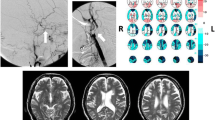Summary
The long-term effect of extra-intracranial arterial bypass on cerebral circulation was examined. Cortical blood flow and cognitive ability were evaluated pre and up to 3 years post-bypass in a 58-years-old man with severe carotid occlusive lesions, who presented with 3 transient cerebral ischaemic attacks which resulted in mental deterioration over 3 years. Regional cerebral blood flow (rCBF) was evaluated pre- and up to 33 months post-bypass by123Iodine N-isopropyl-p-iodoamphetamine (IMP) single-photon emission CT (SPECT). Mental abilities were evaluated before and up to 33 months after surgery by the Hasegawa's dementia rating scale (HDRS).
Pre-operatively, cerebral angiography showed left carotid siphon occlusion and hypoplastic stenosis of left anterior cerebral artery with collaterals from the anterior communicating artery. CT and MRI showed left temporo-parietal borderzone infarction and an enhanced T1 lesion by gadolinium-DTPA at left periventriculum. rCBF showed extensive hypoperfusion in left anterior-parieto-temporal-cortex. HDRS scores deteriorated apparently on days 3, 5, which recovered gradually on days 8, 10, 75 after onset of mental deterioration.
A bypass was performed 4 months after onset. rCBF showed gradual recovery in the left anterior-parietal cortex up to 33 months after bypass. Semiquantitative rCBF showed gradual decreases of regional asymmetry after the bypass. HDRS scores returned to their maximum up to 37 months after onset. Three-year follow-up shows improved cortical rCBF and cognition after the bypass.
Similar content being viewed by others
References
Ackerman RH (1984) Of cerebral blood flow, stroke and SPECT. Stroke 15: 1–4
Anderson DE, McLane MP, Reichman OH, Origitano TC (1992) Improved cerebral blood flow and CO2 reactivity after microvascular anastomosis in patients at high risk for recurrent stroke. Neurosurgery 31: 26–34
Baron JC, Bousser MG, Rey A, Guillard A, Comar D, Castaigne P (1981) Reversal of focal “misery-perfusion syndrome” by extra-intracranial arterial bypass in hemodynamic cerebral ischemia. A case study with15O positron emission tomography. Stroke 12: 454–459
Bishop CCR, Burnand KG, Brown M, Ross Russel R, Browse NL (1987) Reduced response of cerebral blood flow to hypocapnia: restoration by extracranial-intracranial bypass. Brit J Surg 74: 802–804
Creitzig H, Schober O, Gielow P, Friedrich R, Becker H, Dietz H, Hundeshagen H (1986) Cerebral dynamics of N-isopropyl-(123I)p-iodoamphetamine. J Nucl Med 27: 178–183
Fukuda H, Kobayashi S, Okada K, Tsunematsu T (1990) Frontal white matter lesions and dementia in lacunar infarction. Stroke 21: 1143–1149
Hartmann A, Rommel Th, Winter R, Tsuda Y, Menzel J (1987) Measurements of regional cerebral blood flow in patients following superficial temporal artery-middle cerebral artery anastomosis. Acta Neurochir (Wien) 89: 106–111
Hasegawa K, Inoue K, Moriya K (1974) An investigation of dementia rating scale for the elderly. Seishin Igaku (Tokyo) 16: 965–969
Heros RC, Scott RM, Kistler JP, Ackerman RH, Conner ES (1984) Temporary neurological deterioration after extracranial-intracranial bypass. Neurosurgery 15: 178–185
Leblanc R, Tyler JL, Mohr G, Meyer E, Diksic M, Yamamoto L Taylor L, Gauthier S, Hakim A (1987) Hemodynamic and metabolic effects of cerebral revascularization. J Neurosurg 66: 529–535
Nielsen H, Hojer-Pedersen E, Gulliksen G, Haase J, Enevoldsen E (1985) A neuropsychological study of 12 patients with transient ischemic attacks before and after EC/IC bypass surgery. Acta Neurol Scand 71: 317–320
Nielsen H, Hojer-Pedersen E, Gulliksen G, Haase J, Enevoldsen E (1986) Reversible ischemic neurological deficit and minor strokes before and after EC/IC bypass surgery. Acta Neurol Scand 73: 615–618
The EC/IC Bypass Study Group (1985) Failure of extracranial-intracranial arterial bypass to reduce the risk of ischemic stroke. Results of an international randomized trial. N Engl J Med 313: 1191–1200
Tsuda Y, Ayada Y, Takahashi T, Katsuragawa M, Tanabe M, Toyama Y, Matsuo H (1991) Semiquantitative regional cerebral blood flow evaluation using123I-IMP SPECT in a case showing transient ischemic attack caused by putaminal hemorrhage. Acta Neurol Scand 84: 448–451
Tsuda Y, Hartmann A, Biersack HJ, Valerius E, Broich K, Reichmann K (1988) Semiquantifying regional cerebral blood flow by123I-amphetamine (IMP) SPECT in cerebrovascular disorders. Correlations with CBF indices by123Xe inhalation method. Eur J Nucl Med 14: 546–551
Tsuda Y, Kimura K, Iwata Y, Hayakawa T, Etani H, Fukunaga R, Yoneda S, Abe H (1984) Improvement of cerebral blood flow and/or CO2 reactivity after superficial temporal artery-middle cerebral artery bypass in patients with transient ischemic attacks and watershed-zone infarctions. Surg Neurol 22: 595–604
Tsuda Y, Kimura K, Yoneda S, Hayakawa T, Etani H, Kamada T (1986) Recurrent transient ischemic episodes after anticoagulation or bypass operation. Hemodynamic or embolic mechanism. Eur Neurol 25: 290–298
Vorstrup S, Lassen NA, Henriksen L, Haase J, Lindewald H, Boysen G, Paulson OB (1985) CBF before and after extracranial-intracranial bypass surgery in patients with ischemic cerebrovascular disease studied with133Xe-inhalation tomography. Stroke 16: 616–625
Winchell HS, Baldwin RM, Lin TH (1980) Development of I 123 labeled amines for brain studies. Localization of I 123 iodophenylalkyl amines in rat brain. J Nucl Med 21: 940–946
Author information
Authors and Affiliations
Rights and permissions
About this article
Cite this article
Tsuda, Y., Yamada, K., Hayakawa, T. et al. Cortical blood flow and cognition after extracranial-intracranial bypass in a patient with severe carotid occlusive lesions. Acta neurochir 129, 198–204 (1994). https://doi.org/10.1007/BF01406505
Issue Date:
DOI: https://doi.org/10.1007/BF01406505




